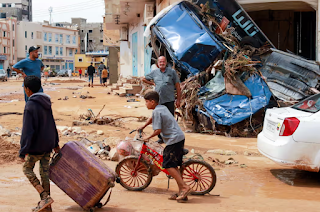Unmasking Global Inequality: The True Cost of 2023’s Climate Disasters
The aftermath of 2023’s most expensive climate disasters reveals a disheartening reality—a "global postcode lottery" that disproportionately affects the poor, according to a detailed analysis by Christian Aid. As wildfires and floods wreak havoc, it is the economically disadvantaged who bear the brunt, further exacerbating the existing disparities in our world.
Understanding the Cost Disparity
The research, unveiled on Wednesday, underlines the striking imbalance in the distribution of costs, ranging from over $4,000 per person in Hawaii for a devastating wildfire to a mere $9 per person in Peru for flooding. This stark contrast illuminates the inherent inequalities in how different regions cope with and recover from climate-induced disasters.
Impact on Vulnerable Communities
The analysis emphasizes that countries with weaker infrastructure and less resilient homes face more significant costs following climate disasters. Areas dependent on sectors like agriculture, vulnerable to extreme weather, are particularly affected. The consequences are twofold: higher casualties and a slower, more unequal recovery.
The Urgent Call for Climate Justice
Patrick Watt, the Chief Executive of Christian Aid, highlights the urgency of addressing this global injustice: "When it comes to the climate crisis, there is a global postcode lottery that is stacked against the poor." The double injustice lies in the fact that communities least responsible for global warming are the ones most affected.
The Role of Loss and Damage Fund
The concept of loss and damage, which entails payments from wealthier countries to those facing the impacts of climate breakdown, becomes crucial. The Cop28 climate summit's promise of just over $700 million to the loss and damage fund falls significantly short of the economic and non-economic losses developing countries endure each year.
In conclusion, as the climate crisis unfolds, it is imperative for governments worldwide to take swift action. Bridging the gap in climate justice requires not only emission reductions but also substantial investments in adaptation, prevention, and a well-resourced loss and damage fund.
Frequently Asked Questions (FAQ)
Q1: What does the analysis reveal about the costliest climate disasters in 2023?
A1: The research exposes a global imbalance where devastating wildfires and floods disproportionately affect poorer nations, exacerbating the challenges faced by those who can least afford to recover.
Q2: How is the per capita cost distributed among different disasters?
A2: The per capita cost ranges from over $4,000 for a wildfire in Hawaii to $9 for flooding in Peru, emphasizing the stark contrast in financial burdens borne by different regions.
Q3: What factors contribute to the inequality in the impact of climate disasters?
A3: The analysis highlights that countries with weaker infrastructure and less resilient homes face larger costs after climate disasters, with areas reliant on vulnerable sectors like agriculture experiencing more significant challenges.

